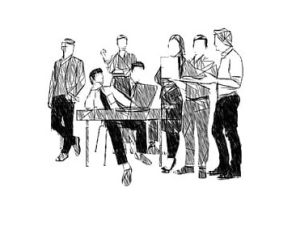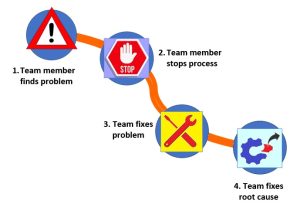What is Lean?
Lean? That’s just the latest fad isn’t it?
Lean has been around for decades. It is now the world’s predominant quality practice in all sectors because it is so effective at invigorating organizations and people’s working lives through a laser-like focus on value for clients.

Starting with A definition of Lean
Lean has gained popularity over many years because it offers “more for less” – meaning more value for your end users and less cost to you, in terms of costs, time and effort.
That’s because Lean is defined as: the heart of an organization where you concentrate on maximizing value to end users and cutting out waste activities in a professional and disciplined way, using the principles and tools presented on this website.
To adopt a Lean approach you have to identify where you create value in your workplace (the Gemba), and then start to remove any activities that do not add value for end users.
And that is markedly different from standard quality systems where the emphasis is on making each process more effective and efficient.
But it all started with Jidoka…

What is Jidoka?
Jidoka is one of the most important Lean methods for ensuring problems – waste – never pass to the next step in a process.
Initially, Jidoka applied to solving mechanical problems at Toyota. But its success led to applying Jidoka to the workforce: managers insist that a team member stops a process if they discover a problem.
But we don’t just stop the process – we highlight the problem, all of the team works to correct it and then we tackle the root cause to prevent the problem ever happening again. The beneficial side effects are the multi-skilling of the workforce and continually improving workplace processes.
A Lean culture is a culture of teamwork, of energy and ideas. It starts with the concept of Jidoka – that anyone in your organization can stop the flow of work as soon as they observe waste – it could be delays, mistakes or failures.
That leads to the “Toyota Way“…

What is the Toyota Way?
Moving forward from Jidoka, where team members support each other to resolve problems, the question was asked again and again: “What are the fundamental elements of a system to get people thinking and working together effectively?“
Toyota used the Jidoka theme to answer this question by a simple system that is shown as a house with the two pillars of Lean quality:
Respect for people – the principle that every team member should be actively engaged in their own development as well as the design and running of their own workplace. The belief in teamwork and respect using Kaizen (small-step improvement) is key to making Lean work.
Managers are expected to go to the workplace and listen to what people have to say about the problems they are facing. Issues are discussed openly rather than concealed. The right conditions are created for every person to succeed at their job through mutual trust, responsibility and good communication
Wisdom and Continual Improvement – every person should be engaged in the design and running of their own workplace. The value of participating through respect and teamwork in a Lean culture is most important. Once respect is established, team members must feel able to contribute to Kaizen. By grasping the principles of Lean and being adaptable, you are aware of the current situation in your workplace and use disciplined steps to achieve future objectives.
What are the principles of Lean?
What are the 5 Lean principles?
In the late 1980s, Jim Womack and Dan Jones were directors of MIT’s International Motor Vehicle Research Program. They coined the term “Lean” with their book “Lean Thinking”.
They set out their five key principles which form the basis for a Lean quality system.